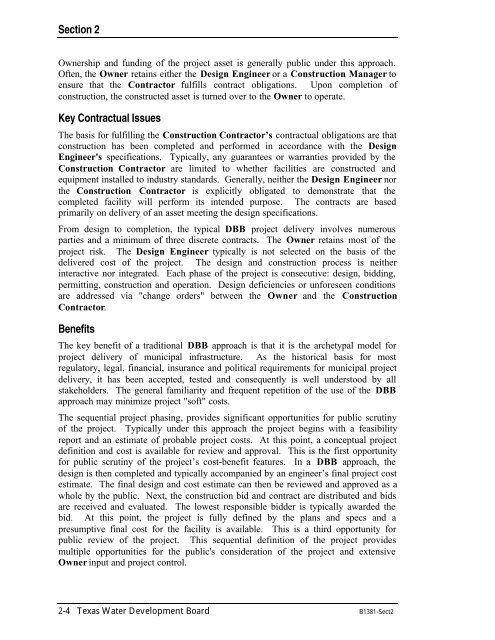Alternative Project Delivery - Texas Water Development Board
Alternative Project Delivery - Texas Water Development Board
Alternative Project Delivery - Texas Water Development Board
You also want an ePaper? Increase the reach of your titles
YUMPU automatically turns print PDFs into web optimized ePapers that Google loves.
Section 2<br />
Ownership and funding of the project asset is generally public under this approach.<br />
Often, the Owner retains either the Design Engineer or a Construction Manager to<br />
ensure that the Contractor fulfills contract obligations. Upon completion of<br />
construction, the constructed asset is turned over to the Owner to operate.<br />
Key Contractual Issues<br />
The basis for fulfilling the Construction Contractor’s contractual obligations are that<br />
construction has been completed and performed in accordance with the Design<br />
Engineer's specifications. Typically, any guarantees or warranties provided by the<br />
Construction Contractor are limited to whether facilities are constructed and<br />
equipment installed to industry standards. Generally, neither the Design Engineer nor<br />
the Construction Contractor is explicitly obligated to demonstrate that the<br />
completed facility will perform its intended purpose. The contracts are based<br />
primarily on delivery of an asset meeting the design specifications.<br />
From design to completion, the typical DBB project delivery involves numerous<br />
parties and a minimum of three discrete contracts. The Owner retains most of the<br />
project risk. The Design Engineer typically is not selected on the basis of the<br />
delivered cost of the project. The design and construction process is neither<br />
interactive nor integrated. Each phase of the project is consecutive: design, bidding,<br />
permitting, construction and operation. Design deficiencies or unforeseen conditions<br />
are addressed via "change orders" between the Owner and the Construction<br />
Contractor.<br />
Benefits<br />
The key benefit of a traditional DBB approach is that it is the archetypal model for<br />
project delivery of municipal infrastructure. As the historical basis for most<br />
regulatory, legal, financial, insurance and political requirements for municipal project<br />
delivery, it has been accepted, tested and consequently is well understood by all<br />
stakeholders. The general familiarity and frequent repetition of the use of the DBB<br />
approach may minimize project "soft" costs.<br />
The sequential project phasing, provides significant opportunities for public scrutiny<br />
of the project. Typically under this approach the project begins with a feasibility<br />
report and an estimate of probable project costs. At this point, a conceptual project<br />
definition and cost is available for review and approval. This is the first opportunity<br />
for public scrutiny of the project’s cost-benefit features. In a DBB approach, the<br />
design is then completed and typically accompanied by an engineer’s final project cost<br />
estimate. The final design and cost estimate can then be reviewed and approved as a<br />
whole by the public. Next, the construction bid and contract are distributed and bids<br />
are received and evaluated. The lowest responsible bidder is typically awarded the<br />
bid. At this point, the project is fully defined by the plans and specs and a<br />
presumptive final cost for the facility is available. This is a third opportunity for<br />
public review of the project. This sequential definition of the project provides<br />
multiple opportunities for the public's consideration of the project and extensive<br />
Owner input and project control.<br />
2-4 <strong>Texas</strong> <strong>Water</strong> <strong>Development</strong> <strong>Board</strong> B1381-Sect2
















